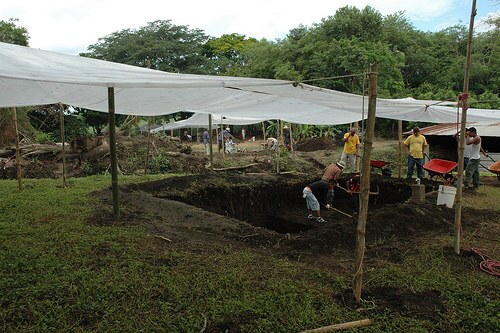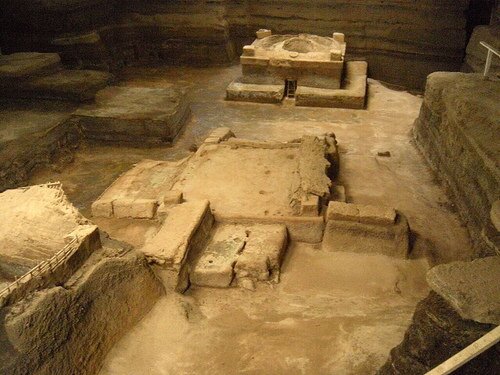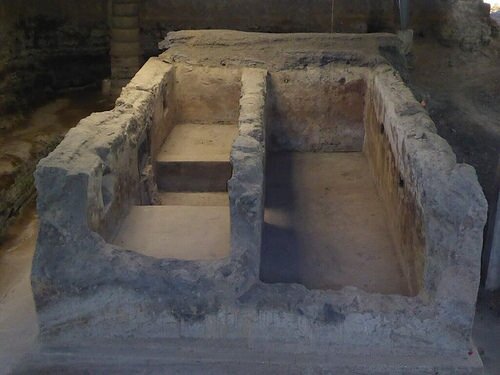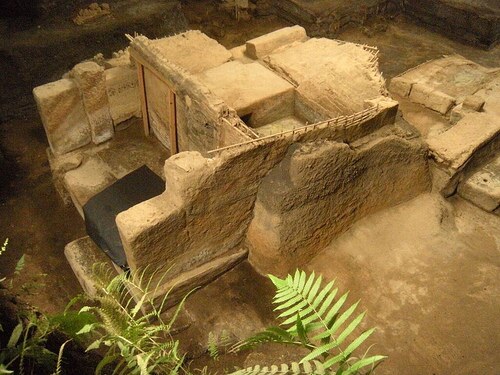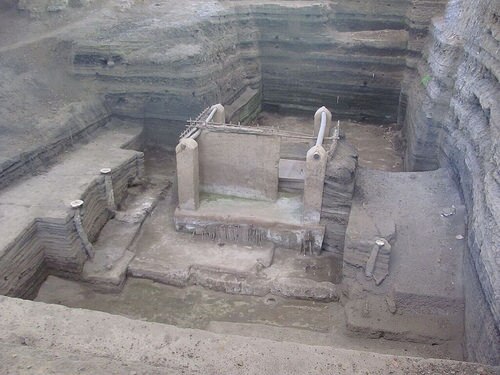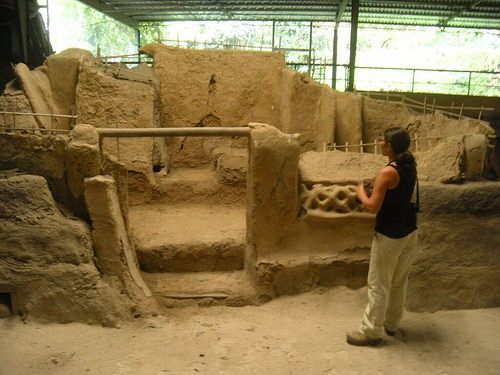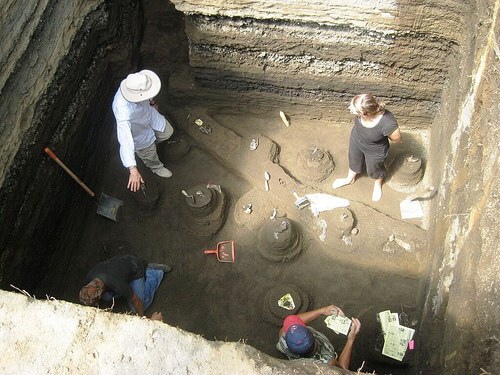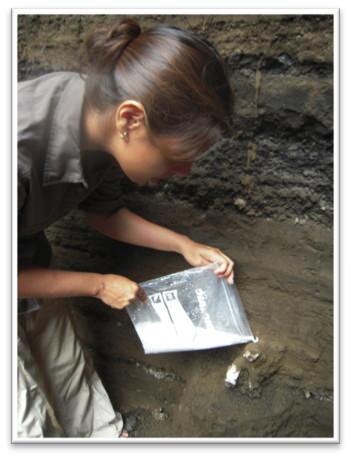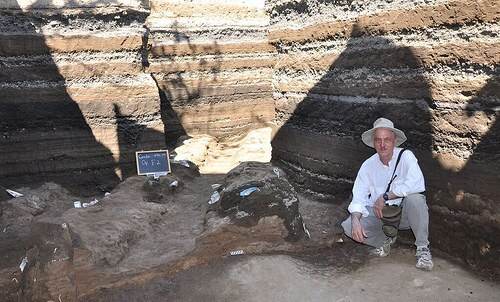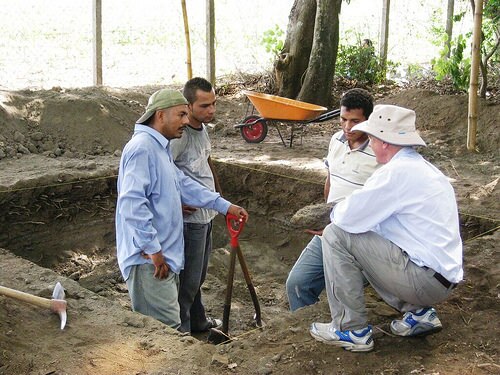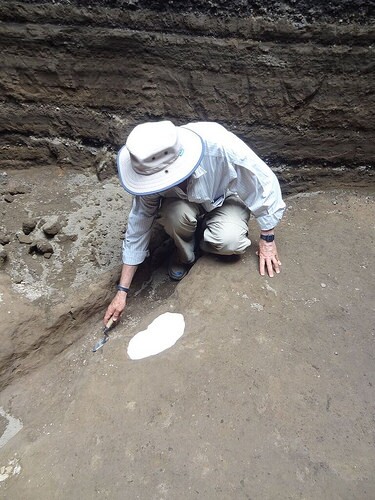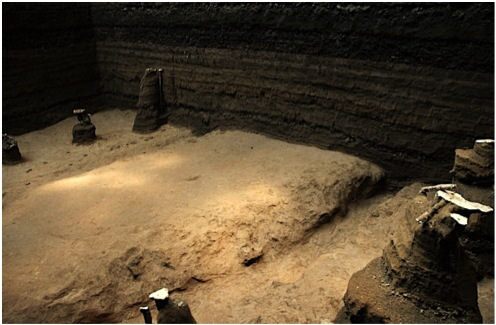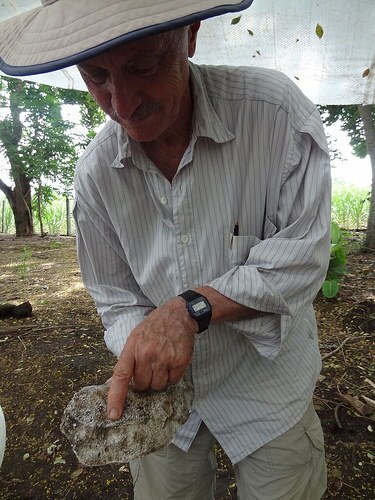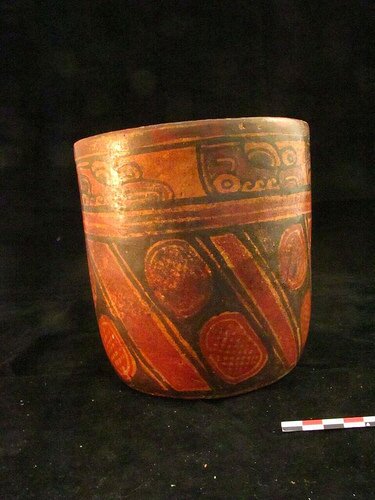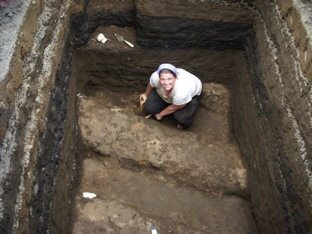
Joya de Cerén, August, 660 A.D.—They knew what to do as soon as they felt the earth tremble.
It was time to get out of town, and quickly.
With not a moment to lose, they gathered what meant most to them—themselves and their families—and fled away as fast as they could. Anyone remaining would have heard the terrifying shrieking sound of the massive steam explosion as the hot magma made contact with the water of the nearby Rio Sucio river, along with the pyroclastic blast that eventually buried the town in a moist, hot volcanic ash.
Within days, where once stood their town amidst a lush green forest and agricultural fields, there was an ash-white desert. They would never return.
Evidence of a Disaster
The forgotten village of Joya de Cerén sits beneath a 17-foot layer of pyroclastic ash, exactly as it was left 1400 years ago in present-day El Salvador during a sudden volcanic eruption from the Loma Caldera volcano, just 600 meters distant. The results of archaeological excavations and research at this site testify to a rapid and desperate departure by the town’s inhabitants soon after their evening meal—tools and religious objects were left unceremoniously and randomly where they were last used, bed mats were left in place, and the fires in the hearths were still dying into embers. It was early August. The harvest was in and people were attending a ritual in one of the community buildings. That summer the farmers had made the decision to grow and harvest manioc, the roots of which are used to make cassava bread. It was feared that a drought might ruin their harvest and that the village would be short on food. Beans and corn fall victim to drought, but the manioc would save them from such desperate conditions. But these plans lost their meaning with the eruption.
For the people of Cerén, it was not the first time their town had been abandoned because of natural disaster. They likely had already heard the stories of a different eruption generations before. Archaeological and geological evidence shows that no earlier than AD 405, the llopongo eruption, centered southeast of present-day San Salvador, had killed an estimated 30,000 people inhabiting a 1000 km area. Around 300,000 people were displaced. Those who repopulated Cerén would surely have told their grandchildren about the devastating event so that by 660 A.D., when the Loma Caldera earthquakes began, the villagers would not waste any time getting out of the way of the onslaught from the pyroclastic blast and the smothering ash.
Cerén, like ancient Pompeii, is an example rarely seen. Nature has made a vivid and detailed impression of life as it was being performed in a moment in time far into the past. In the case of Cerén, cool, fine particles of pyroclastic debris blanketed the community and preserved the forms of thatched roofs, wooden beams, woven baskets and blankets, tools, and adobe structures. Even bean-filled pots, the marks of finger swipes in ceramic bowls, human footprints in gardens and ash casts of corn stalks were left untouched by the effects of time.
Excavations, Manioc, and a Sacbe
Christine Dixon is co-director of the excavations at Cerén, but her career began there nearly a decade ago as a graduate student, assisting in the analysis of Ground-Penetrating Radar scans to identify buried structures. Since completing her Master’s thesis on her experience at Cerén, she has become a leading expert on the day-to-day life of its former inhabitants. But the earliest excavations at Cerén were led by University of Colorado Boulder professor Payson Sheets, who now, along with Dixon, co-directs the excavations. Some of the items he and his team found in a community building included a ceremonial deer headdress, a pot shaped like an alligator, and the bones of a butchered deer. They also recovered the remains of food and animal products. To date, researchers have excavated 12 buildings, including living quarters, storehouses, workshops, kitchens, religious buildings and a community sauna. Dozens of structures remain to be excavated, including the possibility of another settlement or two still buried beneath the Loma Caldera volcanic ash, which covers an area of about two square miles. So far, there have been no human remains recovered.
______________________________________________
Excavations at Cerén in progress. Credit University of Colorado and Christine Dixon
__________________________________________________________________
An excavated household (left), storehouse (center) and community sauna (upper right) buried by volcanic ash at Cerén around A.D. 660. Credit University of Colorado
_________________________________________________
A community building at Cerén believed to have been used by elders to make decisions. Note the two large stone benches. Credit University of Colorado
_______________________________________________________________
A domestic (house) structure. Structures at Cerén were buried in up to 17 feet of ash over a period of several days, freezing the 1,400-year-old village in time. Credit University of Colorado
_________________________________________________________________
An ancient storehouse in the village of Cerén. Credit University of Colorado
___________________________________________________________________
A structure at Cerén used by a female shaman. Credit University of Colorado
___________________________________________________
From their research, a remarkable picture of the life and activities of the people of Cerén has been reconstructed. Based on the archaeological finds and their spatial relationships they determine that the eruption happened sometime near the end of the day. Moreover, beans had just been planted in the advanced stages of the rainy season so as not to disrupt the growth of maize, which was not yet mature. This would likely have been in early August. This latter finding demonstrates the almost unprecedented volume of information that archaeologists have been able to acquire at Cerén reflecting the details of Maya agricultural production.
“Studying agriculture at Cerén is very important because we have evidence that very rarely preserves in the archaeological record,” says Dixon. The Loma Caldera volcanic eruption deposited fine-grained tephra particles, packing around every object at the site, including the individual plants, in addition to covering entire fields of plants, or crops. When archaeologists arrived at the site 1400 years later, they excavated down through the volcanic ash, encountering hollow spaces where there once had been plants. After mixing and applying dental plaster to the exposed cavities, they then continued excavating the area. “The living surface was also preserved by the volcanic ash,” says Dixon. “Thus, in addition to the plants being in their exact location and form as 1400 years prior, we also see the fields where the plants were growing. We have documented the ridges and agricultural beds and can get an extremely detailed view of how plants were grown, in what types of fields and beds, and the cultivation techniques that were used.” Ancient pollen samples have also been taken, indicating the species of crops grown.
Dixon’s research at Cerén reached new levels when manioc fields were discovered. The pyroclastic debris that buried the village was so fine that it created detailed impressions of the plants, making it easy to distinguish them from maize and to identify their beds. These beds have given archaeologists a rare glimpse of the techniques and methods used for growing the crop. Archaeologists are often required to depend on microscopic data to paint a picture of ancient agriculture, but in this case, Dixon and her team also had convenient renderings in which they could actually ‘see’ the details of ridges and beds.
“Since our initial 2007 discovery of manioc beds at Cerén, portions of four manioc fields have been identified to date, all of which had been harvested just prior to the Loma Caldera eruption,” says Dixon. “It is interesting that all of the manioc plants in these fields were harvested at one time, since manioc begins to rot approximately 24 hours after harvest and thus is typically just left growing in the fields until needed. We hypothesize there was a community effort underway to not only harvest, but then to process all manioc, possibly into a flour or fermented beverage.” Dixon and her associates suggest this because they know that today flour and fermented beverages are made from the root crop. It can also be stored indefinitely, and once it is ground up it can be used as a thickening agent in stews or used to make foods like tamales or tortillas. The flour is known today as “almidon”.
_______________________________________________
Professor Payson Sheets, former doctoral student and co-director Christine Dixon and two Salvadoran workers excavating maize by filling ash hollows left by the plant stalks with dental plaster. Credit University of Colorado
____________________________________________________________________
Above: Pouring dental plaster. Credit University of Colorado and Christine Dixon
_________________________________________________________
Professor Payson Sheets, shown here with ash casts of a vast manioc field at Cerén. Credit University of Colorado
_________________________________________________________
What does the manioc tell us about the Classic Period of Mayan culture? This period is often characterized by periods of drought, one of the reasons cited as a possible cause of the Classic Maya ‘collapse’. Manioc and other root crops are highly resistant to these conditions. Farmers at Cerén growing manioc as opposed to maize and other staple crops may indicate a regular precaution in agricultural communities to safeguard against crop failure. According to Dixon, “Scholars have hypothesized that root crops (specifically manioc) might have been an important part of ancient Maya diets and even agricultural insurance (Bronson 1966); however, the scarcity of direct archaeological evidence for manioc cultivation has greatly limited our understanding of the presence and uses of manioc in the past”……..until now. Sheets calculated that the manioc fields at Cerén would have produced about 10 metric tons of manioc every season. The village was not estimated to have had more than 200 inhabitants—not a large enough population to have consumed that much manioc. What were their reasons for producing so much of this die-hard and versatile crop? Perhaps the excess went to surrounding communities, or to the city center, fulfilling the villager’s obligation to the elite. Or perhaps the community kept it for themselves.
An unexpected feature discovered at the site was the sacbe, or road. This would have been constructed over a period of time. Archaeologists suggest from their analysis of archaeological remains that a variety of families would have contributed to building the sacbe—evidence of individuals who would have overseen the construction and maintenance of the road has been found within the preserved dwellings. “We have yet to locate the end of the sacbe either within the site center or to the south, but have learned a great deal about how it was constructed and where it was located,” says Dixon. “It appears multiple sections were likely built by different groups, possibly different families, and that it was a coordinated effort since the road all slopes in the same direction, which would control the water run off.”
Measurements taken by a penetrometer indicated the sacbe was very hard. Archaeologists suggest that this characteristic was in part achieved by the ancient villagers compacting it by pounding sections of the sacbe with heavy objects. This was enhanced by their use of tephra, the angular grains of which could lock together in a tight matrix when compressed under moist conditions. Exposed sections of the sacbe showed that it was slightly grooved, a likely result of people walking single file as they traveled to their fields or the nearby town of San Andres, suggest Sheets and Dixon.
“The western canal of the sacbe was crisp and well formed and had apparently been worked on just days before the eruption,” said Sheets. “But it looks like the workers hadn’t got around to maintaining the eastern canal before the volcanic event.”
So far, several dozen footprints on the sacbe’s outer, softer edges have been revealed. “More than half of the footprints were headed south away from the village, away from the danger,” Sheets said. “I think at least some of them were left by people fleeing the eruption.”
_________________________________________________
Payson Sheets, right, confers with Salvadoran workers digging a test pit down to an ancient white road called a sacbe running in and out of the ancient village of Cerén. The sacbe is buried under 16 feet of volcanic ash. Credit University of Colorado
____________________________________________________________________
CU-Boulder Professor Payson Sheets casting a footprint found on the Cerén sacbe with dental plaster. Credit Rachel Egan, University of Colorado
__________________________________________________________________
Above and below: Views of the Cerén sacbe buried under about 16 feet of ash. The trenches were drainage canals to catch excess rainwater. Credit University of Colorado
_________________________________________________________________
_________________________________________________________________
Professor Payson Sheets points to the imprint of several toes from a footprint left on the Cerén sacbe. Footprints pointed away from village and may have been made by Mayans fleeing the volcanic eruption. Credit Rachel Egan, University of Colorado
_______________________________________________________________
Autonomy in the Countryside
The ancient Maya have been typically depicted as a people ruled by royal elites wielding power and authority from their great monumental ceremonial centers, exacting tribute and controlling affairs much like many other “top-down” societies, where the elite class made most political and economic decisions. But at Cerén, based on Sheets’ and Dixon’s archaeological analysis, the villagers appear to have had significant independence regarding their architecture, crop choices, religious activities and economics. It could have implications for Maya town and village life generally.
“This is the first clear window anyone has had on the daily activities and the quality of life of Maya commoners back then,” said Sheets. “At Cerén we found virtually no influence and certainly no control by the elites.”
Instead, according to Sheets and Dixon, it appears that much power seems to have been vested collectively within the local community. They cite evidence that indicates the residents of particular households at Cerén were responsible for the upkeep of certain community structures, and other households responsible for other specialized activities. One household, for example, contained an inordinate amount of pots and firewood that the researchers speculated were used during activities in a local domed community sauna building. On the larger scale, how the people were organized and directed can also be seen in the style in which the harvest was decided upon and collected, including the layout of the roads. According to Dixon, “From the Cerén agricultural fields it is possible to question how fields were divided, the degree of control farmers had over crop choice and cultivation techniques, and the social and political forces involved……..Our analysis of the buildings, the sacbe, and agricultural fields all suggest that decisions were being made for the community, by the community, rather than imposed upon them by a larger regional force……there was a shared [local] governance at the site, possibility by community elders or a group of community leaders.”
Nevertheless, the archaeologists have deduced a relationship between the Cerén commoners and the Maya elite. It is reflected in the evidence related to public marketplace transactions. Cerén farmers likely traded surplus crops or crafts for coveted, high-end specialty items such as jade axes, obsidian knives and colorfully decorated polychrome pots, items the elites probably arranged to transport to the local market locations from a distance. This, according to the archaeologists, is evidenced in findings that indicated every Cerén household possessing a jade axe—a tool effective for tree cutting, building and woodworking. But even here, it appeared that the community had power and independence. “The Cerén people could have chosen to do business at about a dozen different marketplaces in the region,” said Sheets. “If they thought the elites were ‘charging’ too much at one marketplace, they were free to vote with their feet and go to another.”
“The Cerén community was no doubt in contact with and had a direct relationship with the much larger and more powerful regional centers in the area, like San Andres,” Dixon adds, “but it appears these data suggest that the Cerenians maintained a degree of autonomy and control over their own lives and daily activities.”
_________________________________________________
A polychrome pot unearthed at Cerén. Such pots were prized by the villagers and had likely been obtained through trade at local marketplaces in the valley. Credit University of Colorado
_________________________________________________________________
What’s Next
As with most archaeological projects, the process of study and research could go on for years, and there is still work left to do in terms of excavation and investigation at the site location and its regional context.
“We hope to continue working on documenting how this road articulates with the site center, to examine a key central structure that is likely associated with the road, and to have an opportunity to advance conservation of the building and artifacts at the site,” says Dixon.
Most significantly, Sheets, Dixon and colleagues believe that Cerén is opening a vital window toward understanding ancient Maya life at the village level, an aspect of the Maya that has long missed the limelight due at least in part to the popular focus on the Maya royalty and elite.
A paper on the work at Cerén has been published in Latin American Antiquity, a publication of the Society for American Archaeology. The Cerén research area was declared a UNESCO World Heritage Site in 1993.
_______________________________________________
A few words from Christine Dixon
Dr Sheets is the central person who has propelled and carried the research of Cerén from its discovery to the present. Under his careful leadership and enthusiastic direction, there have been many successful projects over the past three decades of research that would not have been possible without his extraordinary efforts.
There are many individuals who have helped on this project before my arrival, such as Dr. Linda Brown, Dr. Rae Beaubien, Dr. Brian McKee, Dr. Andrea Gerstle, Dr. Scott Simmons, Dr. Inga Calvin, Dr. Stacy Barber, and many others.
My involvement in the site began in 2005 and in that time we have had some terrific teams of researchers aid in our excavations and analyses.
Dr. David Lentz has been a key project member, who helped to co-author multiple grant proposals and had led the paleobotanical analysis side of the project. Dr. Lentz is a renowned expert on the study of ancient plants in Mesoamerica and his work and the work of graduate students Venicia Slotten, Angie Hood, and Christine Hoffer have drastically expanded our knowledge of the huge variety of different plants being used at the site. Each of these students have written master’s theses on their examinations of the paleobotanical remains at the site.
Roberta Gallardo has served as a key project participant and liaison for many years and has facilitated our work at the site.
Our research at the site has included the work of many graduate students. Alexandria Halmbacher has been a terrific project member who has participated in multiple field seasons. Her MA thesis examined the storage practices at Cerén in a careful re-examination of the data from household excavations at the site. Rocio Herrera has been a keymember of our research team.
Celine Lamb is a doctoral student at the University of Kentucky and her Master’s thesis was an analysis of the gardens of Cerén households. Theresa Heindel is currently a doctoral student at the University of California, Riverside and her Master’s research examined the role of malanga at Cerén and in Mesoamerica.
Rachel Egan has also participated in research at the site and is a current doctoral student at the University of Colorado, Boulder whose dissertation research is focused on the Ilopango eruption in El Salvador. Other graduate students who have been involved in our research include: George Maloof, Andy Tetlow, Adam Blanford, Dr. Errin Weller, Monica Guerra, and Joya Tetreault.
Additionally, we have been fortunate to have Dr. Nancy Gonlin join us for the portion of a field season and offer key insight as a consultant on the project. University of Colorado, Boulder professor Dr. Anne Shehaan has also contributed to our geophysical exploration of the site. Finally, none of this research would be possible without the extraordinary efforts of the many Salvadoran workers who have aided us throughout these years of excavation. Their dedication and hard work has truly allowed this research to be possible. The modern day community of Joya de Cerén has provided us a home and remarkable support as we have pursued this research.
— Christine Dixon
Photo image, above left: Christine Dixon excavating the manioc beds. Credit Christine Dixon and the University of Colorado
___________________________________________________
Subscribe to Popular Archaeology Premium. Available on all laptops and mobile devices, and still the industry’s best value at only $9.00 annually.
___________________________________________
Travel and learn with Far Horizons.
____________________________________________
This richly illustrated issue includes the following stories: Recent findings shedding new light on the whereabouts of the remains of Philip of Macedon, father of Alexander the Great; how an archaeologist-sculptor is bringing bones of the dead back to life; archaeologists uncovering town life at the dawn of civilization; an exclusive interview with internationally acclaimed archaeologist James M. Adovasio about what makes the Meadowcroft Rockshelter prominent in the ongoing search for the first Americans; what archaeologists are finding at the site of the ancient city of Gath, the home town of the biblical Philistine giant, Goliath; and how scientists are redrawing the picture of human evolution in Europe. Find it on Amazon.com.

